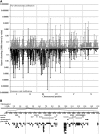Germline expression influences operon organization in the Caenorhabditis elegans genome
- PMID: 19204375
- PMCID: PMC2666493
- DOI: 10.1534/genetics.108.099283
Germline expression influences operon organization in the Caenorhabditis elegans genome
Abstract
Operons are found across multiple kingdoms and phyla, from prokaryotes to chordates. In the nematode Caenorhabditis elegans, the genome contains >1000 operons that compose approximately 15% of the protein-coding genes. However, determination of the force(s) promoting the origin and maintenance of operons in C. elegans has proved elusive. Compared to bacterial operons, genes within a C. elegans operon often show poor coexpression and only sometimes encode proteins with related functions. Using analysis of microarray and large-scale in situ hybridization data, we demonstrate that almost all operon-encoded genes are expressed in germline tissue. However, genes expressed during spermatogenesis are excluded from operons. Operons group together along chromosomes in local clusters that also contain monocistronic germline-expressed genes. Additionally, germline expression of genes in operons is largely independent of the molecular function of the encoded proteins. These analyses demonstrate that mechanisms governing germline gene expression influence operon origination and/or maintenance. Thus, gene expression in a specific tissue can have profound effects on the evolution of genome organization.
Figures




Similar articles
-
A global analysis of Caenorhabditis elegans operons.Nature. 2002 Jun 20;417(6891):851-4. doi: 10.1038/nature00831. Nature. 2002. PMID: 12075352
-
Genome-wide analysis of trans-splicing in the nematode Pristionchus pacificus unravels conserved gene functions for germline and dauer development in divergent operons.RNA. 2014 Sep;20(9):1386-97. doi: 10.1261/rna.041954.113. Epub 2014 Jul 11. RNA. 2014. PMID: 25015138 Free PMC article.
-
Coexpression of neighboring genes in Caenorhabditis elegans is mostly due to operons and duplicate genes.Genome Res. 2003 Feb;13(2):238-43. doi: 10.1101/gr.553803. Genome Res. 2003. PMID: 12566401 Free PMC article.
-
Operon and non-operon gene clusters in the C. elegans genome.WormBook. 2015 Apr 28:1-20. doi: 10.1895/wormbook.1.175.1. WormBook. 2015. PMID: 25936768 Free PMC article. Review.
-
Gene structure and organization in Caenorhabditis elegans.Curr Opin Genet Dev. 1996 Dec;6(6):692-8. doi: 10.1016/s0959-437x(96)80022-0. Curr Opin Genet Dev. 1996. PMID: 8994838 Review.
Cited by
-
To grow or not to grow: nutritional control of development during Caenorhabditis elegans L1 arrest.Genetics. 2013 Jul;194(3):539-55. doi: 10.1534/genetics.113.150847. Genetics. 2013. PMID: 23824969 Free PMC article. Review.
-
Representing ontogeny through ontology: a developmental biologist's guide to the gene ontology.Mol Reprod Dev. 2010 Apr;77(4):314-29. doi: 10.1002/mrd.21130. Mol Reprod Dev. 2010. PMID: 19921742 Free PMC article. Review.
-
Molecular evolution across developmental time reveals rapid divergence in early embryogenesis.Evol Lett. 2019 Jun 19;3(4):359-373. doi: 10.1002/evl3.122. eCollection 2019 Aug. Evol Lett. 2019. PMID: 31388446 Free PMC article.
-
Core promoter T-blocks correlate with gene expression levels in C. elegans.Genome Res. 2011 May;21(5):707-17. doi: 10.1101/gr.113381.110. Epub 2011 Mar 2. Genome Res. 2011. PMID: 21367940 Free PMC article.
-
emb-1 encodes the APC16 subunit of the Caenorhabditis elegans anaphase-promoting complex.Genetics. 2011 Oct;189(2):549-60. doi: 10.1534/genetics.111.131714. Epub 2011 Jul 20. Genetics. 2011. PMID: 21775471 Free PMC article.
References
-
- Blumenthal, T., D. Evans, C. D. Link, A. Guffanti, D. Lawson et al., 2002. A global analysis of Caenorhabditis elegans operons. Nature 417 851–854. - PubMed
-
- Blumenthal, T., and K. S. Gleason, 2003. Caenorhabditis elegans operons: form and function. Nat. Rev. Genet. 4 110–118. - PubMed
-
- Blumenthal, T., and K. Steward, 1997. RNA processing and gene structure, pp. 117–145 in C. elegans II, edited by D. L. Riddle, T. Blumenthal, B. J. Meyer and J. R. Priess. Cold Spring Harbor Laboratory Press, Plainview, NY. - PubMed
-
- Caron, H., B. Van Schaik, M. Van Der Mee, F. Baas, G. Riggins et al., 2001. The human transcriptome map: clustering of highly expressed genes in chromosomal domains. Science 291 1289–1292. - PubMed
Publication types
MeSH terms
LinkOut - more resources
Full Text Sources
Other Literature Sources

